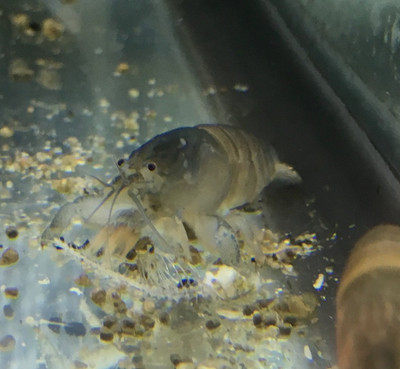The Vampire Shrimp (Atya gabonensis)
Posted by Max Gandara on on 24th Oct 2023
The Vampire Shrimp, scientifically known as Atya gabonensis, is a
captivating and unique freshwater crustacean that hails from the rivers
and streams of West Africa, particularly the Gabon region. This
remarkable creature has gained popularity among aquarists and
enthusiasts for its intriguing appearance, engaging behavior, and the
mysterious moniker it bears.
The Vampire Shrimp is a species of freshwater shrimp belonging to the
Atyidae family. Its scientific name, Atya gabonensis, is derived from
its native habitat in Gabon. Within this family, the Vampire Shrimp is
often referred to as a "filter-feeding shrimp" due to its distinctive
feeding method.
The Vampire Shrimp is immediately distinguishable by its striking
appearance. This species is characterized by a transparent body with red
or maroon eyes, resembling a pair of glowing jewels. These vibrant,
blood-red eyes are one of the primary reasons for its unusual moniker.
Its body is relatively large compared to other freshwater shrimp
species, with an elongated shape and an average length of around 5
inches (12 centimeters).
One of the most remarkable features of the Vampire Shrimp is its unique
pair of specialized appendages known as maxillipeds, which are modified
for filter feeding. These maxillipeds resemble delicate, feathery fans
and are used to capture microscopic particles and detritus from the
water, making them effective filter feeders.
The Vampire Shrimp is native to the flowing waters of West Africa,
specifically Gabon, Cameroon, and Equatorial Guinea. They are commonly
found in rivers, streams, and creeks where the water is fast-moving and
well-oxygenated. These shrimp are typically found in areas with rocky
substrates, where they can anchor themselves using their strong legs to
withstand the currents.
Vampire Shrimps are known for their fascinating feeding behavior. They
are primarily filter feeders, using their specialized maxillipeds to
filter tiny food particles and microorganisms from the water column.
This diet consists of algae, plankton, and various organic matter
carried by the current. Their unique feeding mechanism involves swaying
their fan-like maxillipeds in the water to capture food particles and
directing them towards their mouth.
These shrimp are generally peaceful and non-aggressive, making them
suitable for community aquariums. They do well in groups and are often
seen perched on submerged rocks, using their strong legs to cling to
surfaces.
When keeping Vampire Shrimp in captivity, it is essential to replicate
their natural habitat. This includes providing them with a tank that has
plenty of rocks, caves, and driftwood to mimic their riverine
environment. They are also sensitive to water quality and require clean,
well-oxygenated water with stable parameters. Temperature should be
maintained around 72-78°F (22-26°C), with a slightly acidic to neutral
pH level (6.5-7.5). Adequate filtration is crucial to keep the water
oxygenated and free from pollutants.
Breeding Vampire Shrimp in captivity can be challenging due to their
complex larval stages. However, some dedicated aquarists have
successfully bred them in specialized breeding setups. In the wild,
Vampire Shrimp reproduce through a process of releasing larvae into the
water, which later develop into juvenile shrimp.
The Vampire Shrimp (Atya gabonensis) is an enigmatic and captivating
freshwater crustacean with a unique appearance and fascinating
filter-feeding behavior. Native to the rivers and streams of West
Africa, these shrimp have found their way into the hearts of aquarium
enthusiasts due to their striking beauty and interesting behavior.
Keeping Vampire Shrimp in a well-maintained aquarium can be a rewarding
experience for aquarists who appreciate the intrigue of these remarkable
creatures and the delicate balance they bring to the aquatic ecosystem.
However, it's crucial to provide them with suitable tank conditions to
ensure their well-being and longevity in captivity.

